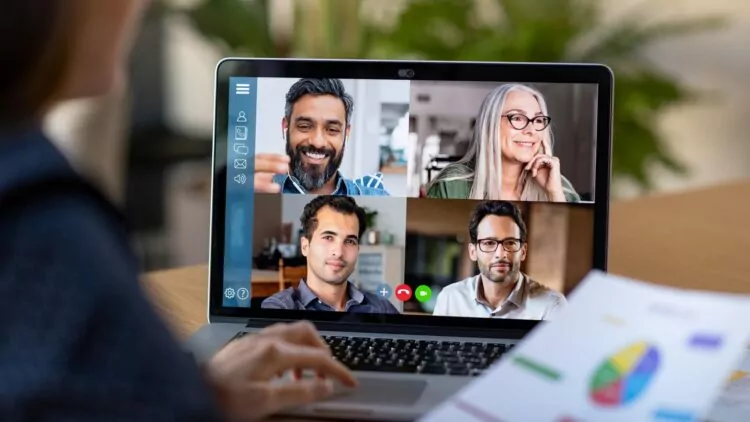In today’s digitally connected world, the idea of making a video call without the internet might sound like a fantasy. But what if I told you it’s feasible achieve an offline video call?
From VoLTE-enabled devices that operate in ways you might not expect, to local networks bypassing the broader internet, to even utilizing analog over-air broadcasting methods – there’s more than one way to communicate visually without a data connection.
Dive in to unravel the mystique of internet-free video calls and discover a realm of communication you never knew existed.
So if you want to learn all about making a video call without internet, then this article is for you.
Let’s get right into it!

Unlocking VoLTE: A New Age of Video Calls Without Internet
There’s a lot to cover with VoLTE.
Depending on your specific goal in researching internet-free video calling, VoLTE will either feel like the best or worst answer.
That’s because it’s kind of a cheat, so let’s talk about how this works.
VoLTE stands for Voice over LTE.
The LTE in this case is the same LTE you see on your phone screen when you check signal strength.
LTE phone networks handle calling, internet, and a whole bunch of other communication.
It’s a robust network with a lot of power.
So, when you make a VoLTE call, you’re using that same LTE infrastructure, which means you’re using a significant portion of the total internet infrastructure.
Your phone is using a lot of the same stuff to browse the internet as it would for a VoLTE video call, but there are some important distinctions.
First, a VoLTE call is not using the legacy phone communication system.
Even though you dial phone numbers for VoLTE calls, under the hood, you’re using IP addresses.
In a carrier network, each phone has an IP address that is assigned using the SIM card.
In other words, your phone connects to wireless carrier networks more or less the same way your computer connects to the internet.
This is why I called VoLTE a bit of a cheat.
You are using internet tools to make the call.
But, it’s still potentially a viable answer because of the second part of what is happening.
VoLTE works on its own SIM/IP system.
Skipping a lot of technical jargon, you can actually be on a video call using VoLTE even while your phone is doing other internet features.
That might sound like it’s already the same as placing a normal call, but those normal calls don’t require an IP address.
Basically, the VoLTE system works simultaneously with and independently from the other internet features on your phone.
To look at this another way, if you place a VoLTE video call, it won’t use up any data on your internet service plan.
That’s the primary reason why I’m listing this first.
You might technically be using internet resources, but you aren’t being billed for the data you use on the call.
Before you get too carried away, most phone providers will charge you by the minute for VoLTE calls, so double-check your contract.
How Do You Actually Make a VoLTE Call?
So far, I told you a lot about what VoLTE is, but I haven’t told you how to actually make a video call using it.
Let’s get into that now.
First, in order to place a VoLTE call, you need VoLTE service.
It’s still relatively new, so not all phones and phone contracts support it.
Getting to that point might require a conversation with your phone provider, so let’s keep this simple.
Start by acquiring VoLTE access.
If you have a phone, and a carrier that allows for VoLTE calls, then the rest of this is easy.
Using your regular phone app, call someone.
You’ll be using VoLTE by default, as it’s becoming the preferred system when available.
Because you are using VoLTE, when you place the call, you’ll get an option.
You can make it a voice-only call, or you can hit the video button and make it a video call.
That’s all it takes. You’re now making a video call without wi-fi or traditional internet by using VoLTE.
The functionality is already built into the phone.
There is a catch, though.
If the person you are calling is not using VoLTE, they might not be able to receive the video feed.
The networks are cross-compatible, so they can still receive an audio call, but in most cases, the video will be dropped.
Either way, they won’t be able to send you videos over a non-VoLTE phone line.

Video Calling on a Local Area Network?
I started with VoLTE because I think it’s the best answer, but there are other ways to skin this apple.
If you truly want to make a video call offline with absolutely no internet access at all (maybe it’s a privacy thing), then there are ways to do that too.
The first one I want to show you is LAN (local area network) calling.
You can set up a local network and place video calls on it without involving the greater internet.
There are two general ways you can do this: with Bluetooth or with Wi-Fi.
Bluetooth is a little harder.
You’ll need a video chat app that is designed to transmit over Bluetooth.
It’s not a standard feature, but it does exist allowing you to truly make a video call offline.
If you can find such an app, then you can video chat with people who are in Bluetooth range.
This is not the most practical solution, and I’ll really get into that in a minute, but it can and does work.
Wi-Fi is a bit more practical.
If you have two devices on the same Wi-Fi network, then they can video chat with each other, even if you don’t have an internet connection.
Let me clarify something.
A lot of times we like to use the terms “Wi-Fi” and “internet” interchangeably, but I’m really leaning into the technical distinction between the two.
While we all often use Wi-Fi to access the internet, the Wi-Fi network is really just how devices near each other communicate.
Internet access doesn’t come from Wi-Fi itself.
Instead, internet access requires some type of modem.
Here’s another way to think about it.
You have one device (your modem) that can actually communicate with the rest of the internet.
The rest of your devices share the modem, and Wi-Fi is the technology they use to manage that sharing.
So, if you remove the modem, you still have Wi-Fi, but you no longer have internet access.
With all of that covered, devices on the same network can video call with each other, even when you’re offline and you don’t have to do anything special to make it work.
They just have to be using the same Wi-Fi.
There is a catch.
Some apps are designed so that they won’t even try to make a video call when you don’t have internet access.
Other apps work fine on just Wi-Fi.
I don’t have a perfect list for you; you’ll just have to explore the app stores and see what works.
What Are the LAN Limitations?
In most cases, LAN video calling isn’t all that useful because it doesn’t have a very good range.
Bluetooth is the exacerbated problem.
It usually has a range of 10 meters or less.
If you’re close enough for Bluetooth connections, then you’re probably close enough to talk face to face.
Sharing documents and such via Bluetooth is convenient, but none of that requires video calling specifically.
Wi-Fi can give you a little more range.
Conceivably, a large office structure or campus with an extended mesh Wi-Fi network might encourage some of this type of video calling.
Someone could be on a different floor of the same building, so you video call to save time.
It makes sense, but in that case, you probably have internet connectivity too.
Still, if you have some really interesting project in mind or a specific reason to video call without internet access, this is a potential way to solve the problem, even offline.

What About Using Someone Else’s Internet for a Video Call?
There’s a completely different possibility.
Maybe you don’t have internet service, but you still want to make a video call.
If that’s the case, then there’s a very easy solution.
Use someone else’s internet service.
Let’s stop and cover a quick disclaimer.
It can be illegal to access another person’s network without authorization.
I am NOT suggesting that you sneakily steal internet access.
There are a lot of legal, and even encouraged ways to get free access to the internet.
Also: When your Facetime says poor connection, how to fix?
You can go with the cliche and use the coffee shop internet.
Maybe a little more practical is going to your local library.
You can connect to their internet, and they might even have conference rooms where you can make a private video call.
You can also connect your device to an internet-enabled device.
This is commonly called piggybacking, and it’s a great solution if your device is damaged and can no longer access the internet on its own (or for any other countless reasons).
Piggybacking is not too hard.
You can plug a phone into a computer with internet access, and you can then use the plug to run the internet to the phone.
Once that is done, you can make your video call.
There are also wireless ways to do this, assuming your Wi-Fi on the phone works.
To save a little time, here are fleshed-out steps to piggyback your phone to another device.
How Did Video Calls Work Before the Internet?
Lastly, I can hit you with the old school.
A lot of people might not realize this, but video calls are much older than the internet.
AT&T was experimenting with such technologies all the way back in the 60s.
Over-air video conferencing essentially uses the same techniques as over-air television broadcasts.
If you have ever seen a TV antenna, that’s what I’m talking about.
There are legacy systems that allow for video calls offline.
One of the most famous is the Picturephone Mod II.
It can connect with another of its type over distances of miles.
You can also try to make your own system.
In essence, you need a microphone, camera, radio transmitter, and radio receiver.
The steps are way too complicated to list here, but it could be a fun project if you want to learn more about wireless and radio transmissions and broadcasting.
There’s one thing you should understand about this means of making video calls.
There is absolutely no security.
This is over-air broadcasting, so anyone with a receiver can hear and see the call.
Anyone with a transmitter could then try to respond.
It’s a lot like using a CB radio or a baby monitor.


